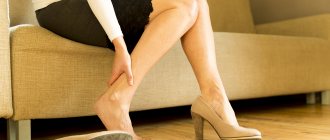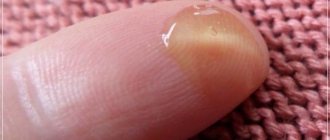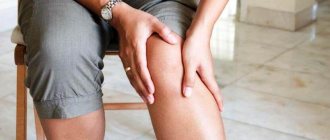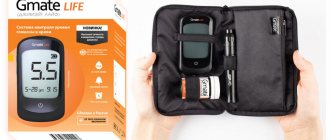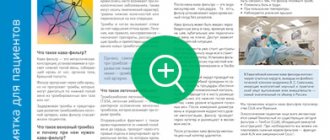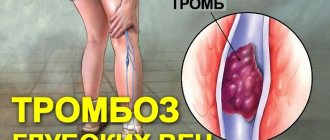Veins are half of the circulatory system.
It is also a source of concern for millions of people around the world.
Vein diseases are widespread. Scientists estimate that up to 15% of middle-aged men and 30% of middle-aged women suffer from varicose veins - dilation of the vessels of the venous system. Among the elderly, the proportion of patients with venous diseases is even higher.
Therefore, many people turn to doctors to treat swollen blood vessels. Sometimes with the help of surgery. In other cases - conservative therapy consisting of medications, exercises and special underwear.
We'll talk about stockings for varicose veins later. In the meantime, let’s evaluate the danger of the disease and its possible complications.
Varicose veins can affect any part of the venous system, but its favorite target is the vessels of the legs.
The vulnerability of veins is explained simply.
When blood flows through the arteries to the organs, it mainly moves downwards. That is, the force of attraction helps blood flow and therefore blood does not usually accumulate in the arteries. It flows through the arteries to the feet. The blood rises back through the veins. At this moment, problems begin - the force of gravity slows down the blood flow, and some of the blood constantly strives to flow down.
The situation is not dire. Yes, blood circulation in the veins is difficult, but the body has protective mechanisms against such trouble.
Venous valves grow inside the vessels, which close the passage of flowing blood and return it to the bloodstream. Muscles also help blood move. They contract and put pressure on the veins, and as a result, blood circulation improves.
In diseased vessels, blood flow is impaired. This happens for various reasons:
- Long immobility
- Obesity
- Elderly age
- Pregnancy
- Hormonal imbalance
In varicose veins, the valves are usually weakened or damaged. Therefore, blood accumulates in certain areas of the vessels, puts pressure on the venous walls and causes expansion.
The symptoms are not the most severe at first:
- Feeling of heaviness in the legs
- Blue or purple blood vessels appear on the skin
- Convulsions
- Edema
- Change in skin color
- Itching and burning in the veins
Such signs of illness often go unnoticed, and sometimes people simply get used to them. Thus, they allow varicose veins to develop.
Yes, it may take more than one year for more severe symptoms to appear. But without treatment, complications are inevitable, and they are not at all as harmless as the first manifestations of varicose veins.
Consequences of advanced varicose veins:
- Trophic ulcers
Non-healing wounds near diseased vessels. The tissues do not receive the necessary nutrients and gradually die. A symptom of an ulcer is the area of skin turning white. To stop the development of complications, you need to consult a doctor as soon as possible.
- Bleeding
Enlarged superficial veins sometimes burst. Bleeding from such vessels is not very severe, but medical attention is still necessary.
- Blood clots
Dilated vessels are a comfortable environment for blood clots, which doctors call thrombi. These formations interfere with blood circulation. They also sometimes come off and can get into the lungs with blood. This phenomenon is called pulmonary embolism and it often leads to breathing problems and even death.
The further the disease progresses, the higher the risk of complications. Another problem is that developed varicose veins usually cannot be eliminated with conservative treatment and surgery is required.
It is much easier to deal with it at an early stage. Complex treatment using stockings against varicose veins shows excellent results. This underwear is also useful for preventing illness.
Why are compression stockings needed for varicose veins?
Varicose veins are associated with impaired blood flow and the inability of the valves to perform their task, which leads to overstretching of the venous walls. Compression knitwear supports blood vessels, preventing them from stretching, restores normal blood circulation, eliminating congestion.
Stockings do not just squeeze the limbs, but do it in each area with different strength:
- in the ankle area the maximum pressure is reached - 100%;
- on the shins the compression is 70%;
- on the hips - no more than 40%.
As a result, blood is correctly pushed through the veins, the vessels are not pinched anywhere, and the risk of blood clots and inflammation of the walls is minimized.
Anti-varicose stockings for pregnant women
During pregnancy, taking care of yourself and your health for the expectant mother comes to the fore. The safest way to stop the progressive development of the disease is to use anti-varicose jersey.
In the third trimester, the maximum load falls on the ankle and lower leg. Anti-varicose stockings, both during childbirth and pregnancy, can provide maximum compression to these areas.
However, before buying anti-varicose stockings, you should carefully read the tips on choosing compression stockings.
Compression jersey for pregnant women
They say that “pregnancy is not a disease.” But such a special period in a woman’s life is associated with the mobilization of all organs and systems aimed at bearing the fetus. The natural growth of the fetus and uterus and the increase in the volume of blood circulating in the body lead to strong pressure on the pelvis and lower limbs. Excessive stress can cause a variety of health problems, including varicose veins. This is why a woman may need special tights or stockings during pregnancy. You don't have to wear them all the time. Much depends on the gestational age, the health of the expectant mother, and other factors.
Some doctors recommend using underwear only during childbirth, especially if the woman is at increased risk of blood clots. The therapeutic effect is achieved by reducing the density of the linen - it will be maximum at the bottom, and in the upper sections it is almost halved. Doctors consider the pressure created to be a physiological norm that ensures the prevention of blood clots. Just a few years ago, this role was played by elastic bandages, but stockings have made a real revolution in this area. Not every woman in late pregnancy, much less during childbirth, is able to independently wrap bandages with the required degree of pressure, but stockings easily and simply solve this problem.
Indications and contraindications for wearing compression garments
Do not buy shaper stockings yourself. First, go to the doctor and check what kind of jersey you need.
Find out the size. Compression ratio. And other characteristics of underwear that you will wear for months.
Buying knitwear without a doctor's recommendation can harm blood vessels. For example, stockings put too much pressure, and as a result, blood circulation in the veins will be disrupted even more. The result is that the condition of the blood vessels worsens.
Make an appointment with a phlebologist about choosing compression garments. Also, read the indications and contraindications for such stockings.
Indications
Doctors prescribe shapewear for the following diseases:
- Chronic venous insufficiency
- Phlebeurysm
- Deep vein thrombosis
- Lymphedema
- Phlebitis
- Lipodermatosclerosis
Also, knitwear is sometimes prescribed to healthy people who are at risk for vascular diseases. The need for stockings arises:
- During pregnancy
The body of the expectant mother is subjected to great stress. Hormonal balance is disrupted. This causes the venous walls to weaken and often expand. The amount of blood in the body also increases. Because of the child. The increased volume of blood greatly increases the load on the walls of blood vessels. Knitwear helps the veins maintain their normal shape under such high pressure.
- Due to increased stress on the legs
At work, many people have to stand on their feet for a long time and therefore the pressure on the vessels of the lower extremities increases. Frequent exercise can cause varicose veins. The underwear supports the veins. So they remain healthy even in people who spend the entire working day on their feet.
- With a sedentary lifestyle
The less a person moves, the more difficult it is for veins to pump blood. The muscles do not work and do not improve blood circulation, so the blood often accumulates and dilates the blood vessels. Knitwear stops the swelling of veins.
- After vascular surgery
The success of surgical treatment largely depends on the correct recovery of the patient. When the procedure is completed, the doctor prescribes knitwear. It must be worn strictly on schedule, since any violation of the regimen can lead to a relapse of the disease.
The correct choice of elastic underwear is very important. Phlebologists prescribe knitwear of a certain degree of compression and class, depending on the patient’s disease and risk factors.
Contraindications
For most people, compression stockings are completely safe. They have only a few restrictions:
- Suspicion of peripheral arterial disease or already diagnosed
- Severe peripheral neuropathy
- Extensive swelling of the legs or pulmonary edema after heart failure
- Allergy to knitwear material
- Skin and soft tissue problems: gangrene, dermatitis, severe cellulite
Some patients simply cannot wear elastic undergarments effectively.
Sometimes only temporarily. For example, they have wounds on their leg and need to wait for them to heal.
In other cases - constantly. For legs of an unusual shape or with deformation, compression hosiery is not suitable. It simply does not grip the limbs properly and therefore will be useless against vein disease.
Compression stocking classes
Therapeutic knitwear has 4 compression classes. A prophylactic one with the lowest degree of compression can be purchased independently for the purpose of prevention, but a therapeutic one must be selected on the recommendation of a doctor. The thing is that such underwear can be both beneficial and harmful to health. With insignificant compression it will not be possible to obtain the desired effect, and too much compression can damage the veins.
4 compression classes:
- Class 1 is characterized by a pressure of 18-22 mm Hg. Art. These stockings are recommended for people at the initial stage of varicose veins. If spider veins begin to appear under the skin here and there, swelling in the evenings, fatigue and heaviness bother you, especially after prolonged physical activity, then it makes sense to purchase a product of this class.
- Class 2 is characterized by a pressure of 22-32 mmHg. Art. Doctors recommend wearing such knitwear to those patients whose vein problems are pronounced, and they periodically provoke complications. We are talking about swelling, cramps in the legs at night, pain in the area of overstretching of the venous walls. If the vessels are noticeably deformed and bulging, then stockings of this class should be worn constantly, especially if there are signs of thrombophlebitis.
- Class 3 is characterized by a pressure of 32-46 mm Hg. Art. Wearing such underwear is prescribed to patients with advanced varicose veins. For those who have trophic ulcers, persistent edema, deep vein thrombosis, postthrombophlebitic syndrome.
- Class 4 is characterized by pressure over 46 mmHg. Art. The main indication for wearing such underwear is lymphedema, as well as severe vein pathologies.
The most widespread were stockings of the first two classes. You can purchase them yourself in a specialized store, but products of classes 3 and 4 are usually made to order, and their operation without outside help is problematic.
Anti-embolic and anti-varicose stockings
Anti-embolic stockings are worn during surgery to prevent air bubbles from entering the arteries. Such bubbles can clog blood vessels and impair blood circulation, which poses a threat to life. Anti-embolic stockings are worn for several days after surgery to avoid blood stagnation and blood clots.
Anti-varicose or orthopedic stockings are intended for the prevention and treatment of vein diseases, which can also lead to the formation of a blood clot. These products are also distinguished by compression. Stockings come with both closed and open toes. Anti-varicose stockings are created especially for women, outwardly indistinguishable from decorative ones. For men, a men's monostocking is available, which can be worn both with one-sided varicose veins, and in pairs with a stocking of lesser or greater compression.
You can understand the difference between the types of stockings using a simple example. During routine surgery and immediately afterward, the patient will wear anti-embolic stockings . Once the postoperative period is over, anti-embolic stockings will no longer be needed. If varicose veins were treated surgically, in the postoperative period the phlebologist will recommend the patient to wear anti-varicose stockings to avoid relapse of the disease. In some cases, wearing anti-varicose underwear is indicated throughout life.
Varicose veins are a disease that occurs in different patients with varying degrees of severity. To figure out what type of medical stockings is needed in a particular case, the concept of compression classes was introduced.
How to choose the right compression stockings
First of all, you need to remember that compression stockings are a specific type of knitwear. You can't buy them in a regular lingerie store. You need to go to a specialized store or pharmacy after taking the following measurements:
- circumference of the lower leg in the narrowest place, that is, in the ankle area;
- circumference of the lower leg at its widest point;
- thigh circumference;
- the distance from the heel to the hip, that is, from the floor to the subgluteal fold.
Experts recommend taking such measurements in the morning, when the legs have not yet had time to swell. The obtained data must be checked against the table on the packaging of the selected product and thus decide on the purchase. Experts recommend paying attention to the quality of the material. Typically, such underwear is made from cotton, lycra, nylon, microfiber, and most often a mixture of two or more threads. High-quality knitwear has a marking that indicates the manufacturer’s data, material, compression class, size, and laundry care requirements. There is no fundamental difference between underwear for men and women; differences may relate to design and color.
Caring for compression stockings
The stockings do not look like a durable product. And indeed, usually their service life does not exceed 12 months, and in many cases the linen breaks and becomes unusable even earlier.
What to do?
First of all, stockings need to be washed. Including knitwear with antimicrobial protection. Remember - you wear elastic underwear all day and dead skin cells constantly accumulate on it. So wash it daily.
It's best to do it manually.
For washing, use baby soap or other delicate products that will not damage the knitwear. You cannot boil laundry.
After washing, squeeze the water out of the stockings very carefully. Do not stretch them, otherwise you will damage the fabric. You can remove moisture with a towel.
Dry knitwear on a flat surface only in cool or warm places, as extreme heat can destroy the material.
Even with proper care, stockings will sooner or later lose their elasticity. Sometimes after just a few months. Less often - after a year.
How to change knitwear in time?
The loss of elasticity is easy to notice in the morning when you put on stockings. Old compression garments stretch very easily. Hence the conclusion - it no longer grips the legs with the required strength and therefore it is necessary to buy a replacement.
How to determine which class of compression stockings is right for you
As already mentioned, stockings of the first two classes were most widespread. But you should not purchase such knitwear without consulting a phlebologist. Only he will be able to select the degree of compression that will not allow the veins to be compressed and will have the desired effect. Experts give the following recommendations:
- It makes sense to purchase class 1 stockings at the first signs of varicose veins - swelling, heaviness in the legs, spider veins. Sometimes there is a need for temporary wearing - during pregnancy, on a hiking trip, during long and frequent flights. People with sedentary jobs also often buy such knitwear, especially if they are overweight.
- Class 2 stockings are indicated for those who have more pronounced varicose veins, areas of swollen veins, and severe swelling and pain. Doctors often prescribe products of this class to their patients after surgery.
Wearing compression class 3 and 4 stockings should only be prescribed by a doctor. It should be remembered that there are pathologies for which wearing compression garments is contraindicated. This applies to serious skin wounds.
Buy compression tights →
See all
- 20% discount
- Leader
Compression tights medi Elegance class 2, small 292
In stock
9,000 rub. from 7,200 rub.
Buy
Code: 007709
medi, Germany
- 20% discount
Compression tights medi Elegance 1 class 191M
In stock
9,000 rub. from 7,200 rub.
Buy
Code: 007706
medi, Germany
- 20% discount
Compression tights Luomma Idealista class 2 dense ID-100 Normal
In stock
RUB 5,120 from RUR 4,096
Buy
Code: 007718
LUOMMA IDEALISTA, Russia
- 20% discount
Compression tights Luomma Idealista 1st class transparent ID-100T Normal
In stock
RUB 5,110 from 4,088 rub.
Buy
Code: 009564
LUOMMA IDEALISTA, Russia
- 20% discount
Compression tights Luomma Idealista class 2 dense ID-100 Long
In stock
RUB 5,120 from RUR 4,096
Buy
Code: 007717
LUOMMA IDEALISTA, Russia
- 20% discount
Compression tights Luomma Idealista 1 class thick ID-100 Long
In stock
RUR 4,620 from RUR 3,696
Buy
Code: 007715
LUOMMA IDEALISTA, Russia
- 20% discount
Compression tights Luomma Idealista 1 class thick ID-100 Normal
In stock
RUR 4,620 from RUR 3,696
Buy
Code: 007716
LUOMMA IDEALISTA, Russia
- 20% discount
Compression tights medi Elegance class 1, small 192M
In stock
9,000 rub. from 7,200 rub.
Buy
Code: 007707
medi, Germany
In stock
RUB 2,750
Buy
Code: 007776
ORTO, Spain
In stock
RUR 2,585
Buy
Code: 007770
ORTO, Spain
In stock
RUR 3,025
Buy
Code: 007773
ORTO, Spain
In stock
RUB 8,700
Buy
Code: 007694
medi, Germany
In stock
RUB 8,700
Buy
Code: 007695
medi, Germany
- 20% discount
Compression tights medi Elegance 2 class 291
In stock
9,000 rub. from 7,200 rub.
Buy
Code: 007708
medi, Germany
In stock
RUB 5,350
Buy
Code: 007702
medi, Germany
- 20% discount
Compression tights medi Comfort class 2, small CC217
In stock
RUB 8,700 from 6,960 rub.
Buy
Code: 007697
medi, Germany
In stock
RUB 5,350
Buy
Code: 007704
medi, Germany
- 20% discount
Compression tights medi Comfort class 2 CC210
In stock
RUB 8,700 from 6,960 rub.
Buy
Code: 007696
medi, Germany
In stock
8,000 rub.
Buy
Code: 007824
medi, Germany
How long can you wear compression stockings?
You need to put on compression stockings in the morning immediately after waking up, before your legs are swollen. Wear until evening, and remove before hygiene procedures and bedtime. The higher the compression class, the harder it is to put on such jersey. Experts advise that when purchasing stockings of class 2 and higher, immediately purchase special rubberized gloves. They make it easier to put on and take off, and also prevent damage to the product by nails or jewelry. Stockings must be regularly looked after, washed in moderately warm water with mild soap, and dried naturally without the use of heating radiators and preferably horizontally, laid out on a flat surface.
Timely washing not only helps maintain hygiene, but also preserves the compressive properties of the linen. Under such conditions, the same stockings can be worn for up to six months.
How not to buy a fake
To buy high-quality compression hosiery, you need to carefully choose the manufacturer. Unfortunately, fakes can often be hidden under well-known brands. Therefore, you need to buy underwear only from specialized retail outlets, and even better from certified distribution networks. In such networks, a company representative can give practical advice, take all the measurements himself and help you choose the right type of knitwear.
Medical compression garments have their own quality standards. The highest standard is European RAL-GZ-387. All manufacturers who use it on their packaging undergo certification in leading centers in Germany and Switzerland. The presence of such a certificate guarantees that compression products actually create a physiologically correct pressure distribution in the ratio of 100%/70%/40% and have a therapeutic effect. The standard must not only be printed on the packaging, but also on a label that is sewn into the product itself.
Prevention of varicose veins
Stockings by themselves cannot eliminate varicose veins. They can only alleviate the patient’s condition and prevent the development of severe consequences, so the prevention of varicose veins comes to the fore, which consists of giving up bad habits and normalizing weight if there is a problem of obesity. It is very important to avoid heavy physical activity. Static veins are also harmful to the health of veins, so people with sedentary work need to get up and stretch more often. Women need to stop wearing high-heeled shoes all the time, leaving them only for special occasions.
Patient questions about compression therapy
Can varicose veins (varicose veins) be treated with compression stockings?
Compression stockings or knee socks will help cope with some of the symptoms of varicose veins (swelling, heaviness), and compression is also a good prevention of complications of varicose veins. However, only removal of varicose veins can completely rid you of such a disease as varicose veins.
Is it useful to wear compression hosiery for varicose veins? Will it impair blood circulation?
The use of compression hosiery improves pathologically altered hemodynamics in varicose veins and has an extremely positive effect.
Can compression stockings be used for trophic venous ulcers?
The use of compression therapy in the presence of a trophic venous ulcer is a necessary component of treatment, without which it is almost impossible to achieve healing of the ulcer.
How long should I wear compression after surgery?
Most patients are advised to wear compression stockings for about three to four weeks after varicose vein surgery. In some cases, the period of wearing compression can be changed upward or downward.
Features of use
The main advantage of tights, stockings and knee socks is the fact that when you purchase them, you immediately receive a product that is guaranteed to perform its functions (subject to the correct size selection).
This means that you can simply put on the underwear, distributing it evenly, after which it will begin to have a healing effect. Tights, stockings, knee-highs and socks can be worn all day long, regardless of the type of activity. However, in this matter it is still important to consult with a phlebologist, who will give precise recommendations regarding the duration of wearing and the subtleties of use, because each case of the disease is unique.
In addition, in order for the laundry to last a long time, it is necessary to handle it properly:
- Wear carefully to avoid damaging the compression stockings.
- You should wear underwear only on dry skin (if you previously used cream, wait until it is completely absorbed).
- To evenly put on tights, stockings or knee socks, first insert your hand into them, then spread them evenly and gradually along your leg.
- Experts also recommend putting on underwear in the morning immediately after waking up, that is, before you get out of bed.
Using a bandage
An elastic bandage is a cheaper and at the same time unpretentious product. However, for its correct use, it is important to master at least the basics of the technique of bandaging limbs for varicose veins. To do this, you should follow these recommendations:
- The bandage is wound from bottom to top, starting from the foot, from the toes, then the ankle, moving higher. Depending on the nature and prevalence of varicose veins, you can start from the lower part of the leg, without affecting the foot.
- Apply the strips slightly overlapping, this will achieve maximum efficiency, and this technique will also prevent the bandage from slipping or unraveling.
- If the foot is wrapped, when moving to the shin, the heel remains free, and at the junction between the ankle and shin the wraps are placed crosswise.
- You should not unwind the roll of bandage too much; it should be assembled and located almost close to the leg so as not to create excessive tension.
- Remember that on the lower part of the leg the compression should be higher, and as you lift the tension gradually decreases.
There is a way to check that the bandage is applied correctly. Immediately after wrapping, the toes become blue, which should go away after 2-3 minutes. If there is no cyanosis at all, the bandage is wound too loosely; if the effect does not go away, you have achieved too much compression, unwind the bandage, massage your leg and try again.
